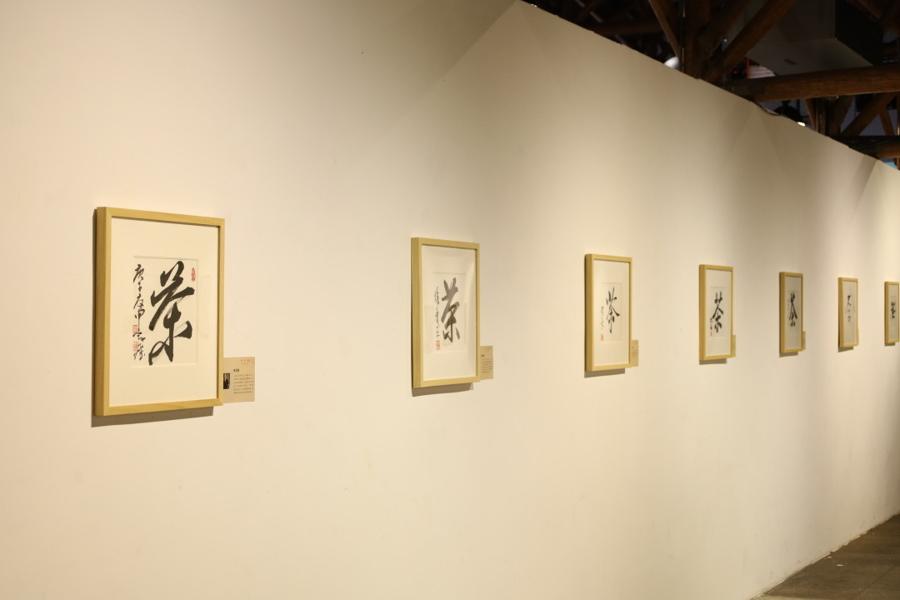
From academicians of the two academies such as Zhang Luqian and Cheng Tianmin, to cultural figures such as Xu Yuanchong, Jia Pingwa, and Mo Yan, to calligraphers and painters such as Lin Ximing, Chen Jialing, and Sun Xiaoyun, more than a hundred well-known people wrote the word "tea" one by one, which was recently exhibited at the "One Book, One Tea, One World - Hundred Teas to Meet Friends" exhibition located in Yunjian Granary Cultural and Creative Park in Songjiang District, Shanghai. This exhibition is also due to the origin of the "Zen and Tea One Taste" Huiming Temple in Jingning, Zhejiang, and Shanghai.
"What's going on in the mountains? Pine flowers make wine, spring water makes tea." As one of the seven necessities of life (firewood, rice, oil, salt, soy sauce, vinegar and tea), drinking tea was very common in ancient China. Chinese tea culture has a long history and is extensive and profound. After Lu Yu wrote the "Tea Classic" in the Tang Dynasty, the spirit of tea permeated all aspects of Chinese society, spread to Japan and overseas, and penetrated into Chinese poetry, painting, calligraphy, religion, and medicine. In the poems and essays of the ancients, tea is not only material, but also spiritual. Looking at the history of tea, it can be said to be the evolution of Chinese lifestyle aesthetics, as well as a history of art.
"For Chinese people, drinking tea is almost a must. Tea is an important part of life and also represents a state of mind. I am very happy to see so many famous artists writing about the word 'tea' today, including generals, scientists, artists, and writers. From the perspective of traditional history and culture, Chinese tea culture is the link between material life and spiritual pursuits, forming a unique oriental wisdom system." said the well-known artist Chen Jialing at the exhibition.

Exhibition site

Exhibition site
According to the organizers, under the same theme of "tea", these writers include 14 academicians of the two academies, including Zhang Luqian, Cheng Tianmin, Chen Zongmao, Jin Yong, Zeng Yitao, Sun Handong, Yan Jiaan, Ma Guoxin, Fan Mingwu, Han Qide, Wu Shuoxian, Su Guohui, Su Yinao, Zhang Zhiyuan, etc., 15 well-known cultural figures, including Xu Yuanchong, Wang Meng, Jiang Kun, Jia Pingwa, Mo Yan, etc., 54 famous calligraphers and painters, including Lin Ximing, Hou Yimin, Han Meilin, Chen Jialing, Dai Dunbang, Han Tianheng, Zhang Sen, Tong Yanfang, Liu Yiwen, Sun Xiaoyun, etc., in addition, there are diplomats such as Li Zhaoxing, Yang Jiechi, Cui Tiankai, Zhang Qiyue, and many Buddhist masters such as Huiming and Zewu who wrote the word "tea". Among them, more than 30 people live and work in Shanghai, which also makes this group of calligraphy treasures permeated with the rich Shanghai cultural charm.

Famous calligraphy “Tea” on display

Famous calligraphy “Tea” on display

Famous calligraphy “Tea” on display
This exhibition is inspired by the origins of Huiming Temple in Jingning, Zhejiang, Huiming Tea and Shanghai. Huiming Tea is the only tea in history named after a Buddhist monk.
Huiming Temple is located in Jingning She Autonomous County, Lishui City, Zhejiang Province, the only autonomous county for ethnic minorities in East China. It was first built in the second year of Tang Xiantong (861 AD) and originated from the Tang Dynasty monk Huiming. In 661 AD, Huiming monk traveled across mountains and rivers to Jingning to preach and taught local people the skills of tea planting and tea making. He also used tea as medicine to treat diseases caused by plague for the people. In order to express gratitude to Huiming monk, local people named the tea trees they planted "Huiming Tea" and built a temple "Huiming Temple" to commemorate Huiming monk. The tea produced in the tea garden around the temple was named "Huiming Tea", forming the cultural origin of "Zen and Tea are One".

Jingning Huiming Temple

Statue of Huiming, a Tang Dynasty monk
In 2018, Master Huiming, the abbot of Shanghai Jing'an Temple, took the lead in cooperating with the People's Government of Jingning She Autonomous County to raise funds and officially launch the renovation and expansion project of Huiming Temple in October 2022 to restore the magnificent atmosphere of this thousand-year-old temple.
The exhibition also exhibited signed works and documents by tea experts such as Wu Juenong, Zhang Tianfu, and Chen Zongmao. The event also specially planned and launched the "Bright Moon Rising from the Sea: Paintings of the Book of Songs, Tang Poems, and Song Lyrics", which exhibited more than 50 excellent paintings based on the Book of Songs, Tang Poems, and Song Lyrics by Lin Ximing, Chen Jialing, Dai Dunbang, Han Tianheng, Yang Zhengxin, Xiao Haichun, Che Pengfei, Le Zhenwen, Ding Xiaofang, Wang Jiafang, He Xi, Bao Ying, etc. These works use ink and wash to outline the long poetic rhyme, and build a bridge of millennium cultural context between the flow of pen and ink, which echoes the "Hundred Tea Friendship Exhibition".

Exhibition site
According to reports, after the exhibition at Songjiang Yunjian Granary, the exhibition will be held at the China She Nationality Museum in Jingning, Zhejiang on May 9 and at Shanghai Jing'an Temple on May 28. The exhibition is guided by the Culture and Tourism Bureau of Songjiang District, Shanghai, and the Agriculture and Rural Bureau of Jingning She Autonomous County, Zhejiang Province, and hosted by Huiming Tea and Zen Culture Research Institute and Shanghai No. 8 Bridge (Group) Company.
- wGbnowFfiGbIDIm04/24/2025